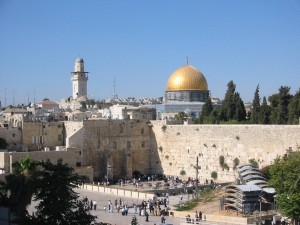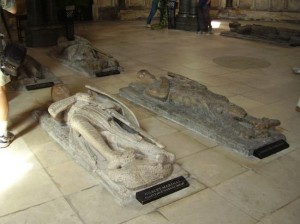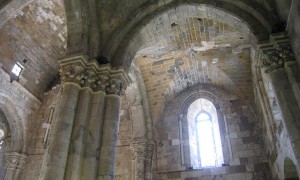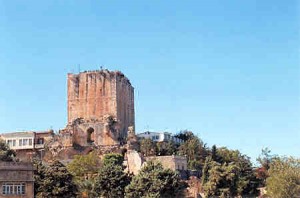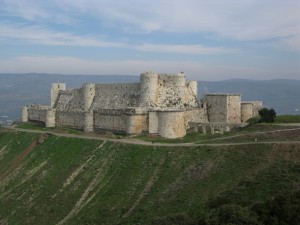The Knights Templar Landmarks
The Knights Templar Headquarters – Temple Mount
In 1099, Christian Crusaders seized Jerusalem from Muslim rule. There are many famous Bible stories about Jesus that take place at Temple Mount, including challenging Jewish leaders of corruption and extortion. The Knights Templar set up their headquarters in the mosque at Temple Mount. The symbolic importance of this meant that the Knights Templar were now physically connected to all of the biblical events taking place at this location. The collection of warrior knights and religious monks were perfectly embodied with this location. Beneath the mosque, 60,000 square feet served the purpose of stabling their horses to constantly be ready to defend Jerusalem. The Templar Knights were now centrally located in the Holy Lands.
Temple Church, English Headquarters
Temple Church in London, the English headquarters, was built in 1185 to replicate the Holy Sepulcher in Jerusalem. Christians believe that this is the site where Jesus died, was buried, and rose from the dead. The Initiation ritual of the Knights Templar takes place in the Temple Church. New recruits would enter through the west at dawn and the doors would be locked behind them. They passed between statues on the floor of the temple before they took vows of poverty, chastity, and obedience. The statues lay on the ground as if in coffins and were meant to symbolize those who gave the greatest sacrifice to the Templar Knights. The Knights would be servants to the Templars and God forever.
The Knights Templar Stronghold – Tortosa
Tortosa was the main shipping point for incoming goods and outgoing communications. To serve their purposes in the city, Templars built a great hall where knights plotted against their enemies. The room featured arched ceilings over 50 feet high. Also still standing, the chapel of Knights Templar in Tortosa features 50 feet high ceilings, and a great room 80 feet long and 30 feet wide. This massively beautiful structure also features gothic style arches and is a testament to the importance of prayer to the knights templar. The castle also featured a keep where the Knights Templar would train for their battles. Within the keep, a cistern still sits serving as a vital water supply in the case of a Templar Retreat. Next to the cistern, evidence of a weapons store is found where Templars would retrieve swords, shields, and crossbows. In 1291, after further fortifying the Keep within Tortosa, Muslim forces would force a retreat by the Templars. The Keep is the only remaining structure completely in tact from the Knights Templar. The evidence and relics of the Knights Templar city Tortosa can be found in present day Tartus on the Mediterranean sea in Syria.
Chastel Blanc
25 Miles from Tortosa, Chastel Blanc stood as a combination of the Knights military force and christian religion. The building stands over 100 feet above the highest peak and provides sight lines from the Mediterranean sea to the mountain ranges of Lebanon and Tripoli. On the ground floor, a church still stands. The church features arrow slits that are perfectly masoned to provide the best shooting angles for the archers in the building while providing the most defense possible on all floors as well. In addition, the military fortification also has a cistern cut into the rock below the building. Above the church is a dormitory on the second floor and from the roof, Templars could see their other defense points, Tortosa, Krak Des Chevaliers, and Chastel Rouge. This provided a defensible position over very valuable and fertile land.
Krak des Chevaliers
Krak des Chevaliers is another 25 miles from Chastel Blanc, and according to Lawrence of Arabia, it is the finest castle in the world. Built by a rival group, The Knights Hospitaller, Krak des Chevaliers was manned by both the Knights Hospitaller and the Knights Templar during the late 1190s. Krak des Chevaliers features 7 30 feet wide guard towers and outer walls 100 feet thick. The castle defends the main road that connected the inner holy cities to the coastal powers. Krak des Chevaliers was built with latest advancements in technology, masonry, and military strategy. The stables were built to hold thousands of horses. The slow sloping floors meant that the animals could effectively and safely climb around the castle. This masterful masonry is still impressive considering the sloping hill that the entire castle is built on. The castle has secret passages to be able to gather intelligence and deliver supplies all throughout the main defense wall. The main defense wall was also sloping greatly, which stopped attackers from tunneling below the wall. Supplies would be delivered to archers as well as those manning the machicolations on the main wall. An engineering feat during their time, machicolations enable defenders to hurl items such as rocks or boiling water on enemies below.
